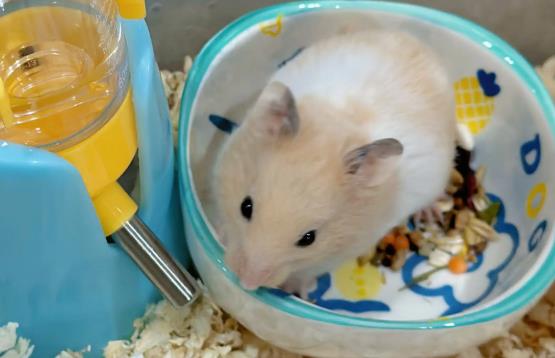Below is a detailed explanation of how hamster water dispensers work, including the features and ideal uses of different types. This guide will help you understand their operation more intuitively:

I. Vacuum-Pressure Water Dispensers: Air-Powered Flow Control
How They Work
Vacuum-pressure water dispensers regulate water flow using a physical air pressure difference. When the water bottle is inverted, the air inside becomes sealed, creating a vacuum. Atmospheric pressure outside the bottle “holds” the water inside. When a hamster licks the (steel ball) at the spout, a tiny amount of outside air enters the bottle, breaking the vacuum. Gravity then pulls water out of the spout. When the hamster stops licking, the vacuum reforms, and water flow stops automatically.
Key Advantages
Strong Leak-Proofing: The vacuum design eliminates leaks at the source. Even if the hamster bumps the dispenser or it’s jostled during transport, no water will seep out.
Quiet Operation: Water flow makes barely any noise, so it won’t disturb the hamster or its owner’s sleep at night.
Fresh Water Preservation: Reduced contact between air and water slows bacterial growth, keeping the water clean.
Flexible Installation: Most come with adjustable brackets, fitting different cage heights and hamster sizes (e.g., dwarf hamsters or Syrian hamsters).
Ideal Uses
Suitable for all hamster breeds, especially active individuals that tend to knock over water dispensers. For example, Syrian hamsters may frequently bump their cages while playing—vacuum-pressure dispensers prevent water from soaking bedding.
II. Ball/Chopper-Style Water Dispensers: Simple Mechanical Activation
How They Work
Ball-Style: A rolling steel ball is built into the spout. When the hamster licks the ball, it pushes the ball aside, and water flows through the gap. When the hamster stops licking, the ball rolls back into place, sealing the spout.
Chopper-Style: Similar to a ballpoint pen mechanism. When the hamster licks the spout, it pushes a small “chopper” (plunger) inside, and water flows out through a tiny hole. When the hamster stops, the plunger springs back, stopping the flow.
Key Advantages
Affordable: Simple design means lower prices, making them a good choice for owners on a budget.
Easy to Use: Hamsters don’t need to learn how to use them—they figure it out quickly. Perfect for first-time hamster owners.
Multiple Size Options: Available in capacities (50ml–300ml) that fit small dwarf hamsters to large Syrian hamsters.
Potential Issues
Leak Risk: Wear on the ball/chopper or improper installation can cause dripping. Check the spout’s seal regularly.
Noise: The rolling ball or springing plunger may make faint sounds, which could disturb sleep at night (place the dispenser in a corner of the cage away from sleeping areas).
Water Contamination: Debris from the hamster’s mouth or cage can get into the bottle via the ball/chopper. Clean the dispenser 1–2 times a week.
Ideal Uses
Suitable for calm hamsters that rarely knock over water dispensers, or as a backup option. For example, (Campbell’s dwarf hamsters) have gentle personalities and rarely tip over dispensers—ball-style models work well for them.
III. Water Bowls: Natural Drinking, High-Maintenance
How They Work
An open container holds water, and the hamster drinks by lowering its head—mimicking its natural drinking behavior.
Key Advantages
Physiologically Friendly: Eliminates the need for the hamster to tilt its head to drink, reducing strain on the spine. Ideal for elderly hamsters or those with joint issues (e.g., Roborovski dwarf hamsters over 8 months old).
Easy to Clean: No complex parts—just use a soft brush and warm water to clean thoroughly, reducing bacterial growth.
Potential Issues
High Contamination Risk: Dust and bedding easily fall into the water. Change the water and clean the bowl daily (ceramic or glass bowls are recommended—they’re hard to tip over and easy to clean).
Tipping Hazard: Hamsters may knock over the bowl while moving around, soaking bedding and increasing the risk of skin infections or colds (secure the bowl to a corner of the cage or weigh it down with a heavy base).
Space-Consuming: Requires a fixed spot in the cage, which may take up room for the hamster to move. Best for large cages (e.g., 60cm+ basic cages).
Ideal Uses
Suitable for owners with enough time to maintain them daily, or as a supplementary drinking option. For example, in summer, you can use both a water bowl and a dispenser to encourage the hamster to drink more water.
